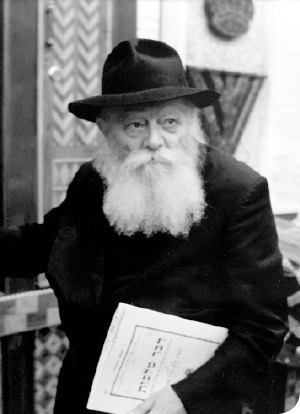Beis Moshiach presents the maamer the Rebbe MH”M delivered on Yud Shvat 5719, in accordance with the custom established by the rebbe to review each year a section of the Rebbe Rayatz’s Hemshech “Basi L’Gani” of 5710. • This year we focus on the ninth section of the profound and foundational Chassidic discourse. * The conclusion of Section 4
Translated by Boruch Merkur
 HOW LOW CAN ATZMUS GO?
HOW LOW CAN ATZMUS GO?
To explain these three analogies: The concept of “The higher something is, the lower it descends” entails drawing down from Atzmus to the lower worlds, Bria-Yetzira-Asiya. In the highest of the four worlds, Atzilus, “He and His energy are one; He and His vessels are one.” Indeed, Atzilus is called “Olam HaElokus – the World of G-dliness.” “The lower it descends” clearly does not refer then to Atzilus. “Low” refers, rather, to the Created realm, the worlds Bria-Yetzira-Asiya.
As explained at length in the maamarim of Chodesh Tishrei, the process of hamshacha that takes place within the worlds Bria-Yetzira-Asiya is in the order of light, water, sky.* Light-water-sky corresponds to the three analogies respectively: The analogy of the torch corresponds to light; bucket to water; and the seminal drop corresponds to sky, for the firmament congealed [into physical space], taking on a new mehus [as the birth of a child is a new mehus]. Thus, water that has frozen loses the status of being “drawn water,” to the extent that according to some opinions it does not disqualify a body of water to be used for a mikva. Rather, it contributes to the amount of water required, and from the outset it can be used for a mikva (Mikvaos 6:1; Tur Shulchan Aruch Yoreh Deia 201:31).
Now, it is explained in drushei Chodesh Tishrei that the process of light-water-sky is not only applicable to Bria-Yetzira-Asiya, but also to Atzilus, as well as Kesser, and higher still, including even the light that precedes the Tzimtzum. Thus, the veracity of all three analogies – torch-bucket-drop – is maintained even at these primordial heights, and in each place and level the greatest height is revealed specifically in its lowest aspect. (That is, the greatest height of any given world is revealed specifically in the lowest aspect of that world.)
Now, in the general Seider HaHishtalshlus, “the lower it descends” refers to the revelation of Atzmus within the created worlds, reaching Olam HaAsiya. There in the lowest world, the greatest height of Divinity – Atzmus Itself – is revealed, G-d’s essence which is higher than even the greatest height relative to Atzilus, beyond Atzilus, and prior to the Tzimtzum. Atzmus is revealed specifically in the very lowest of all. This descent is described as “tachton tachton,” a repetitive expression, indicating the lowest possible dimension: Olam HaAsiya – there is nothing below it.
Thus, the amudim, the pillars of a great mansion – representing G-d’s grandeur – are said to be standing specifically on the earth, for “in the place of G-d’s greatness, there you find His humility.” Throughout the entire Seider Hishtalshlus there is the light-water-sky process at all levels [whereby, as above, the highest aspect of any given world or dimension is revealed in its lowest aspect]. But the revelation of the very highest of all, Atzmus, occurs specifically in the very lowest, the world of Asiya, and within Asiya itself, not the spiritual dimension of Asiya but the physicality of Asiya.
From this it is understood that also within the physical Asiya itself, the greatest height can only be revealed at its lowest level. That is, the revelation of Atzmus is not in the spiritual avoda performed within Asiya, but in its physicality. Also, for this reason, Likkutei Torah is precise in saying (in drushei Tzitzis) regarding the analogy of pillars standing upon the ground, that in order for the pillars to firmly support the structure and the roof upon it, there must be a foundation of hard earth, not loose soil. The same applies to Mitzvos: they need to be on “hard ground,” which are Mitzvos invested within physicality, as it concludes in Likkutei Torah: “asiya l’eila.”**
NOTES:
*Footnote 37: Maamer “Torah Tziva” and “Tzur T’uda” of this year, 5719, Toras Menachem Vol. 24, pg. 138 ff; pg. 175 ff. [A selection from the latter: “Every hamshacha that takes place follows the order of light-water-sky. That is, revelation begins at the level of Divine light, light that has not yet taken on form. The revelation then attains the aspect of water, which has some discreet existence but still maintains its p’shitus, its simple formlessness. Finally, the G-dly manifestation is complete when it takes on the aspect of sky, d’aglidu maya, for then it is formed in all its detail.”]
**The phrase “asiya l’eila – action is superior” is found in Seifer HaZohar (Zohar I 8a; III 53b). Maaseh-action is the lowest of the three garments of the soul [i.e., thought, speech, and action], and it is the end and conclusion of all the soul-powers, Nevertheless, it is specifically action that embodies the notion of “their end is wedged in their beginning.” Also, the essence of the soul, as well as the essence of Divine light, is manifest through action. (Translation of a selection of the entry for “maaseh” at http://chabadpedia.co.il/index.php/מעשה)
(To be continued, b’ezras Hashem)